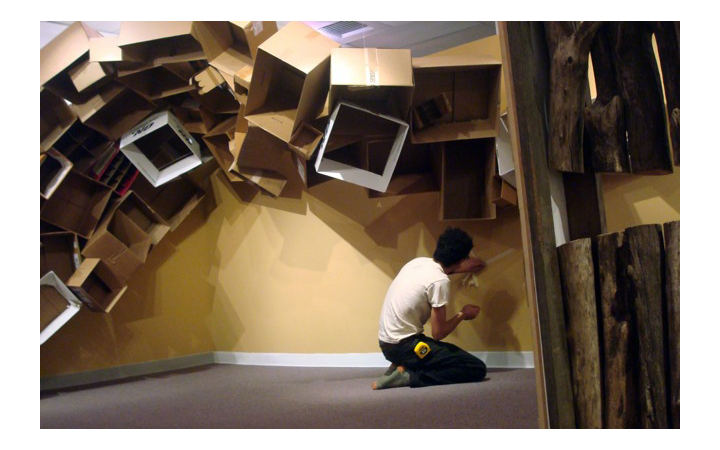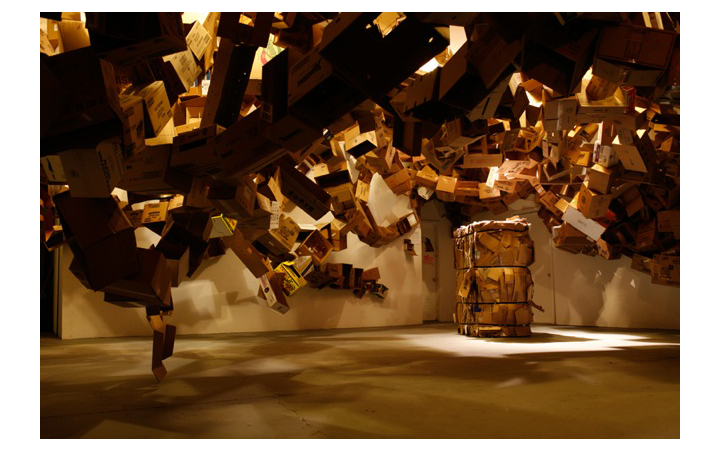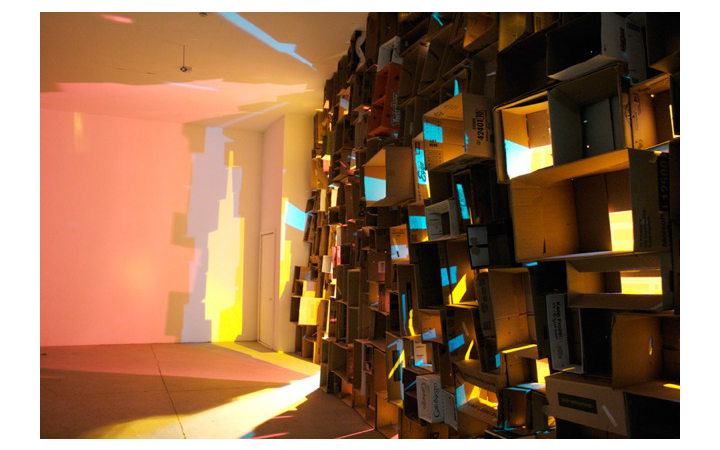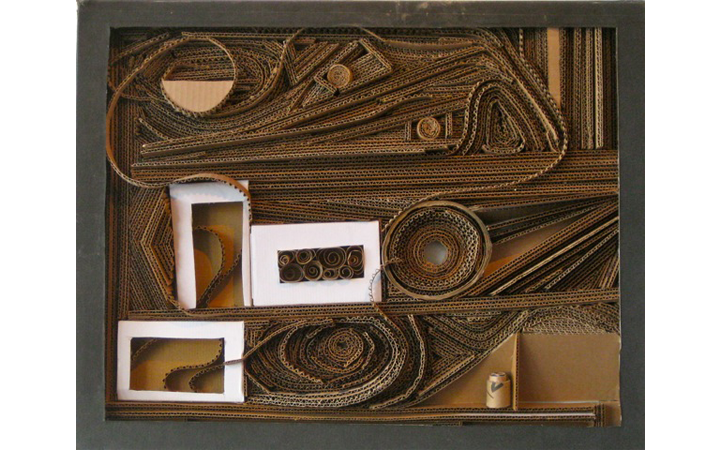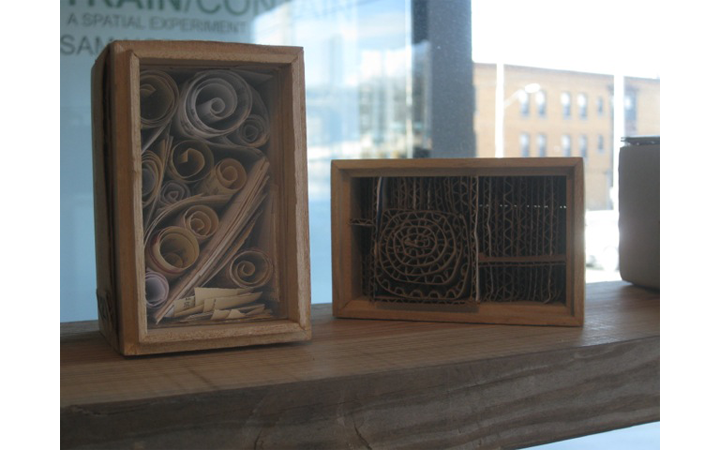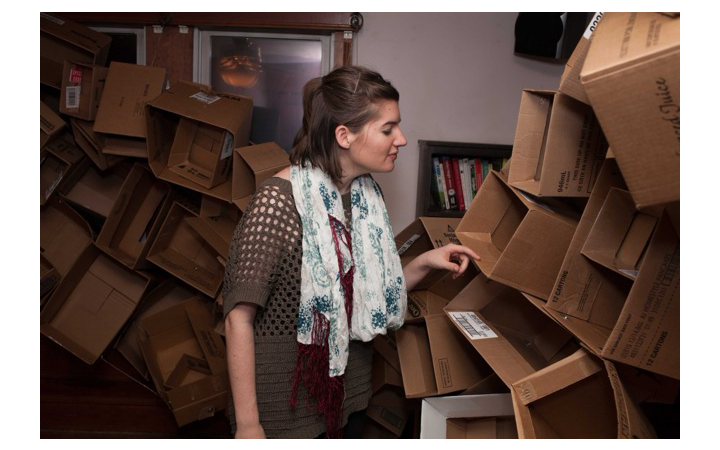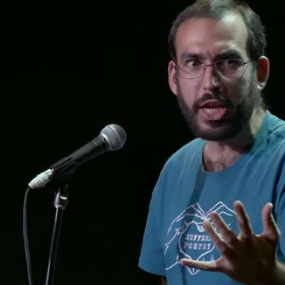–Meet the Artist:Sam Horowitz–
Q: What is Environmental Art?
A: In the words of Richard Serra, “Environmental Art involves the creation or manipulation of a large or enclosed space, which effectively surrounds its audience.” I see it as art about relating to space, and the physicality of the work, or area of work experienced. Not all of my work is environmental, but most all of it shares a tactility and process. This stems from the sensation of occupying the same physical space as the work. Much of my art is meant, or able, to be touched. This interaction between object and viewer (or activator) is principal to my work.
Q: How did you get involved in sculpture?
I don’t have a huge amount of patience for tasks where I cannot immediately see the results of my hand. Much of the time, I start working from a vague conception of where I’d like to finish, but it is the resulting work that quickly commandeers my plans, and the piece ends miles from where I’d anticipated. I’ve been working with some drawings, and recently some photography and video experiments, but in the end, I get the most satisfaction from physically digging into my materials. I suppose my first truly sculptural experience was “Clay in Art,” in high school; but also years before, amid rescued milk jugs and taped paper towel tubes, under my mother’s feet in the kitchen.
Q: Favorite medium to work in? Can we get a why?
A: I’ve been working a lot with cardboard, paper, and repurposed boxes. Not only are all these materials free, but they are also very present in our lives. A friend actually mistook one of my pieces for “some sort of Apple product” because of the packaging (a work inside a clear plastic iPod Touch box). I enjoy this reference, be it designer (Apple) or mundane (old wood tool boxes). I have been working increasingly with found natural wood and construction salvage, as it maintains these same easy associations. I aim to allow for many levels of interpretation within my work, so as to give a universal audience access to the wonder, beauty, and theories I strive to define and illustrate.
Q: What inspires you to create?
A: Since leaving school, I have been working full-time doing a mix of carpentry, farming, landscaping and studio-assistance. I always carry my phone with me, if not a true camera, and I find myself taking photos everywhere I go. Occasionally, these pictures turn into the work themselves. Most often it is the textures, repetition, color, and forms I find in my documentation that inspires work. I also feel an affinity for artists I work for, and their shared energy. After working closely with another’s creative process, I enjoy returning home to my own drawing board and exploring what I could only aid with before.
Q: Name an artist you are wow’d by?
A: I have been interested in the work of Tobias Putrih for some time. He explores cardboard and other salvaged materials, and encourages audience participation. I really respect the work; both aesthetically and conceptually. I recently discovered Florian Baudrexel, thanks to the New York Style magazine. I enjoy the compartmentalism of Louise Nevelson, the heft and motion of Richard Serra, and the whims and palette of Phoebe Washburn.
Q: When you create, do you typically listen to music? And if so, what?
A: I am always listening to music. Right now I’m on a Deer Tick binge, incorporating other groups like The Black Keys, tUnE-yArDs, and The Tallest Man on Earth. Pandora’s fun, but I prefer exchanging playlists with friends. Upbeat music keeps me working, but ambient tunes help me think…The first 30’+ wall I made was almost exclusively built to Infected Mushroom.
Q: Any recommended reading?
A: I wish I could finish one of the tens of books that’s dog-eared on my bedside table… to pick out a few: Cloud Atlas (David Mitchel), The Poetics of Space (Gaston Bachelard), Eating Animals (Jonathan Sfran Foer), and Donkey Gospel (Tony Hoagland).
Q: Are you an action, comedy or romance man, and what film would you then recommend?
A: I like movies. Usually movies someone else recommends. And if you ask if I’ve seen it, chances are I haven’t. I guess I don’t prioritize watching things – most often I’d rather be doing things. But I do love making popcorn on a stovetop, and movies go so well with popcorn.
Q: We know being an artist is a lot of work, so what drives you to keep going?
A: I work full time for an extremely successful painter. I mow his grass. But simply being around him, his magnificent property and his multiple studios is inspiring. There is such beauty everywhere: be it million-dollar plaster walls, yellow dying grass blowing in a field, or the mundane order of a well used work table. I can’t not create. There were two periods since embracing art that I wasn’t actively working. The first was in college: I took 4 academic classes and no studio classes, and earned my lowest GPA ever. I needed the release of artistic creation to calm me down and center my focus. The second time was just after graduation, when I became engaged for a 6-month stint. That was an unhealthy relationship. I made no art; I was unconsciously constrained. Art may function as a barometer in my life – as long as I’m steadily plodding away, even just sketching out ideas, I know I’m feeling good.
Q: Most entertaining/interesting/boring story from a previous show?
A: I had a solo show at Syracuse University last winter, which was my first show out of college. I worked the allotted 5 days 12+ hours each, and was quite proud when I finished the night before the opening. And then I switched from “work” clothes to “opening” clothes: dress pants, wingtips, white shirt and suspenders… a friend of the gallery manager and herself an art critic took one look at me: “It appears Mr. Horowitz is part of the show himself…” I suppose overdressing is better in most cases than underdressing, but I felt pretty foolish.
Q: Best and worst pieces of advice you’ve ever gotten?
A: The best advice I have ever received was during a class at Bard with the artist Judy Pfaff. In conversation during the first week of the semester, she frowned at the isolated, contained, mouse-hole-of-a-cave I had built. “You’re doing this.” She held out clenched fists. She opened them, gesturing to the wall, the ceiling and the surrounding space beyond. “Do this.”
I can’t think of a bad piece of advice I ever took seriously. Perhaps I’ve blocked them from my memory, or I’ve been lucky, or I’m too optimistic. All in all, though, the only mistakes I’ve made have been completely my own.
Q: How do you think the Internet has changed art?
A: What hasn’t the Internet changed? The fact that I can see a photo of a Rodin, or a Marden, or a Serra, or a grad student thesis project at Yale speaks to the speed at which artwork, concepts, and inspiration may travel. Never before has it been so easy to see art, or have so many people been “into” art; either as collectors, collaborators, curators, or are just plain curious. In this way, I think the Internet speeds up the collective conscious (or unconscious) that creates art movements and “makes” artists. Not to say more artists are being “made,” but I think (and hope) that it may be easier to be found now than ever before. Or at least seen.
Check out more work from Sam: Website | Contact Sam
Want to be our next featured artist? Send us a message with some info (links, who you are, what you do) to theteam [at] allwegotrecords [dot] com
